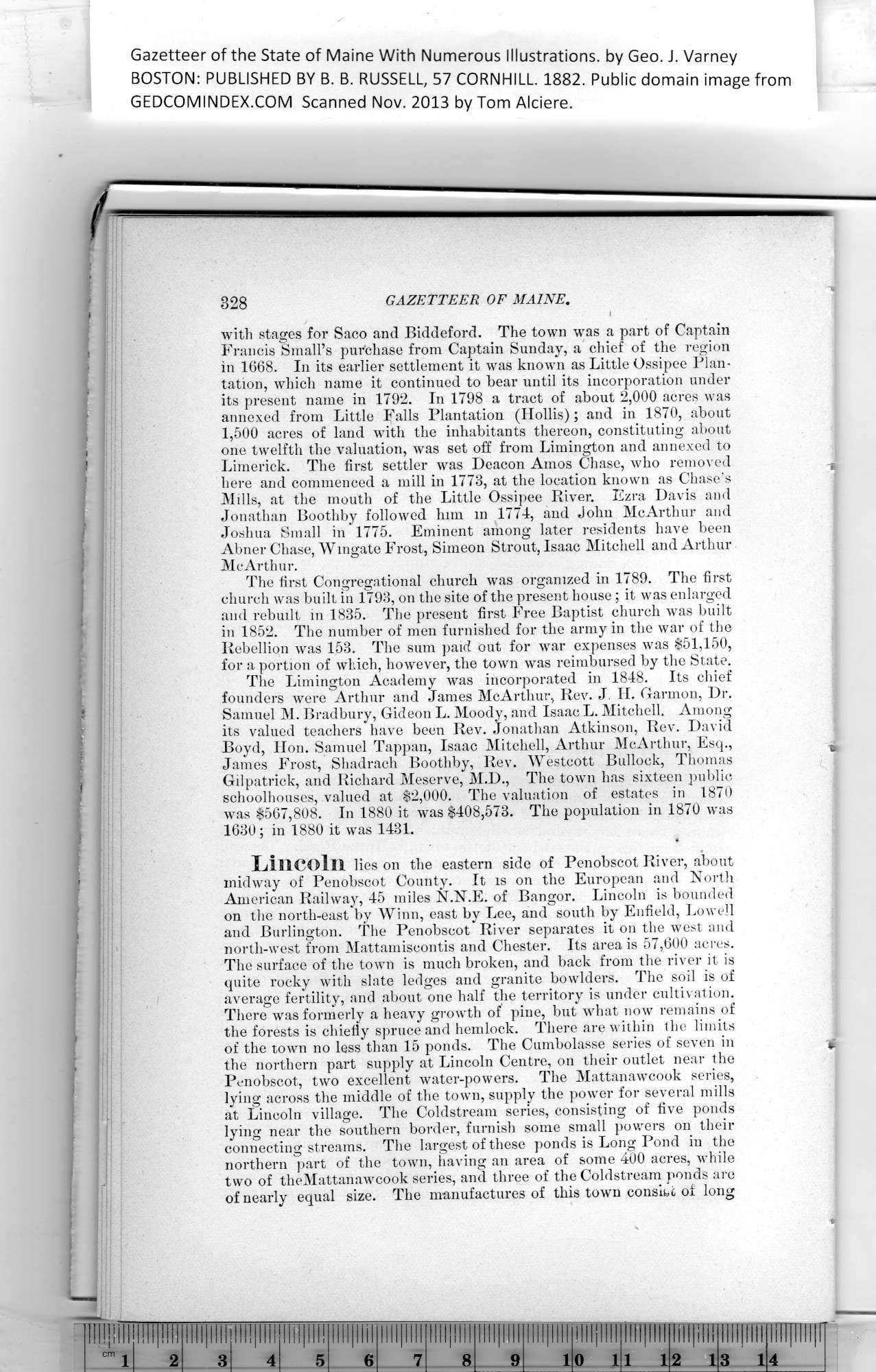|
Gazetteer of the State of Maine With Numerous Illustrations, by Geo. J. Varney
BOSTON: PUBLISHED BY B. B. RUSSELL, 57 CORNHILL. 1882. Public domain image from
328 GAZETTEER OF MAINE.
I
with stages for Saco and Biddeford. The town was a part of Captain
Francis Small’s purchase from Captain Sunday, a chief of the region
in 1668. In its earlier settlement it was known as Little Ossipee Plan-
tation, which name it continued to bear until its incorporation under
its present name in 1792. In 1798 a tract of about 2,000 acres was
annexed from Little Falls Plantation (Hollis); and in 1870, about
1,500 acres of land with the inhabitants thereon, constituting about
one twelfth the valuation, was set off from Limington and annexed to
Limerick. The first settler was Deacon Amos Chase, who removed
here and commenced a mill in 1773, at the location known as Chase’s
Mills, at the mouth of the Little Ossipee River. Ezra Davis and
Jonathan Boothby followed him m 1774, and John McArthur and
Joshua Small in* 1775. Eminent among later residents have been
Abner Chase, Wingate Frost, Simeon Strout, Isaac Mitchell and Arthur
McArthur.
The first Congregational church was organized in 1789. The first
church was built in 1793, on the site of the present house; it was enlarged
and rebuilt in 1835. The present first Free Baptist church was built
in 1852. The number of men furnished for the army in the war of the
Rebellion was 153. The sum paid out for war expenses was $51,150,
for a portion of which, however, the town was reimbursed by the State.
The Limington Academy was incorporated in 1848. Its chief
founders were Arthur and James McArthur, Rev. J. H. Garmon, Dr.
Samuel M. Bradbury, Gideon L. Moody, and Isaac L. Mitchell. Among
its valued teachers have been Rev. Jonathan Atkinson, Rev. David
Boyd, Hon. Samuel Tappan, Isaac Mitchell, Arthur McArthur, Esq.,
James Frost, Shadrach Boothby, Rev. Westcott Bullock, Thomas
Gilpatrick, and Richard Meserve, M.D., The town has sixteen public
schoolhouses, valued at $2,000. The valuation of estates in 1870
was $567,808. In 1880 it wras $408,573. The population in 1870 was
1630; in 1880 it was 1431.
Lincoln lies on the eastern side of Penobscot River, about
midway of Penobscot County. It is on the European and North
American Railway, 45 miles N.N.E. of Bangor. Lincoln is bounded
on the north-east by Winn, east by Lee, and south by Enfield, Lowell
and Burlington. The Penobscot River separates it on the west and
north-west from Mattamiscontis and Chester. Its area is 57,600 acres.
The surface of the town is much broken, and back from the river it is
quite rocky with slate ledges and granite bowlders. The soil is of
average fertility, and about one half the territory is under cultivation.
There was formerly a heavy growth of pine, but what now remains of
the forests is chiefly spruce and hemlock. There are within the limits
of the town no less than 15 ponds. The Cumbolasse series of seven in *
the northern part supply at Lincoln Centre, on their outlet near the
Penobscot, two excellent water-powers. The Mattanawcook series,
lying across the middle of the town, supply the power for several mills
at Lincoln village. The Coldstream series, consisting of five ponds
lying near the southern border, furnish some small powers on their
connecting streams. The largest of these ponds is Long Pond in the
northern "part of the town, having an area of some 400 acres, while
two of theMattanawcook series, and three of the Coldstream ponds are
of nearly equal size. The manufactures of this town consud of long
PREVIOUS PAGE ... NEXT PAGE
This page was written in HTML using a program written in Python 3.2
|
